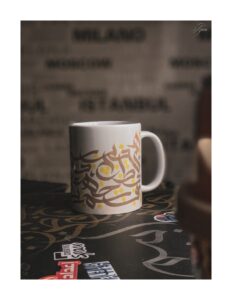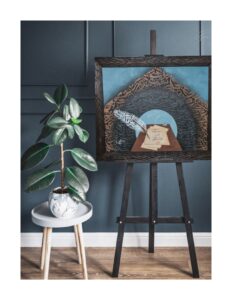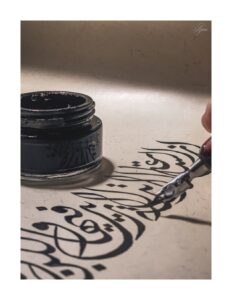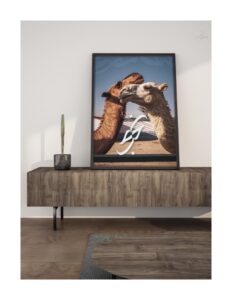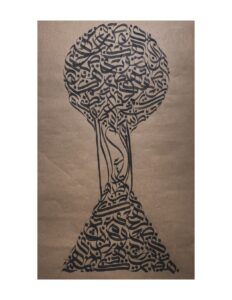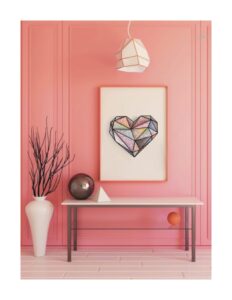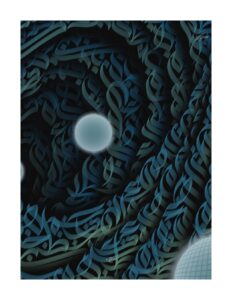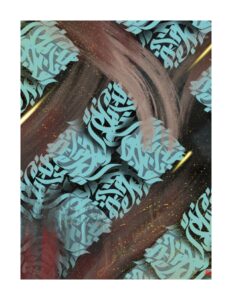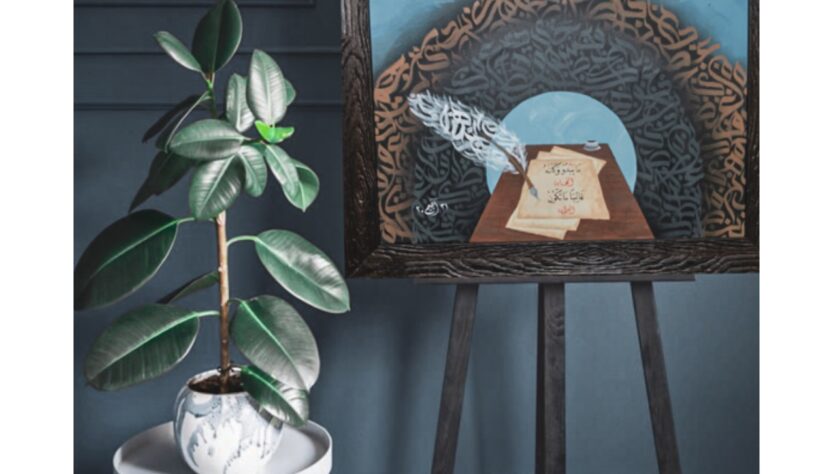Calligraphy is an art of designing letters and words in a form different from normal writing that we use in our daily life. It can be drawn by using special tools like pen, ink brush or other writing tools, and on different drawing papers. Recently this type of art can be written through digital platforms not just on drawing papers. It developed in forms like using Calligraphy in making logos, signs, and even piece of art which could be readable or unreadable.
Ibrahim Hassan, a student of TIU’s Interior Design Department, uses different styles and techniques of calligraphy to present his creativity and talent. Some of his works are created with ink pen and some with digital tools that have special concept and idea in his art. He talked to Shayan Magazine for an exclusive interview to explain more.
Shayan: Can you tell us about yourself?
Ibrahim Hassan: My name is Ibrahim, and I’m a student at interior design engineering department. I have four years of experience in calligraphy, two years of freelancing experience and one year of graphic design experience.
Shayan: Since when and why you started calligraphy?
Ibrahim Hassan: I always had a passion for works related to Arabic calligraphy when I was young, and in 2018, my colleague, who is now a medical student in Mosul, was taking lessons in the Ruqaa calligraphy and was publishing her works on social media. One day, I was encouraged and went to her and asked her about the tools required for a novice learner and decided to start learning, but in another way, which is through lessons on YouTube. From there, my story began with Arabic calligraphy and I began to learn Naskh calligraphy. In two years I learned brie the casbah, aging paper, and making Arabic ink on the old ways. Then I started to turn to other types and Arabic calligraphy. I began to study a little about the Diwani calligraphy and the Ruqaa calligraphy. Then, in the year 2020, I got to know a new type of Arabic calligraphy, which is – the Wissam line, and it is a line that is characterized by flexibility and ease. It is used in the field of design, and here began another new story, which is the employment of Arabic calligraphy in graphic design and integrating it into other artistic fields such as pop art.
Shayan: Shich styles you are using mostly in your calligraphy works?
Ibrahim Hassan: I am specialized mainly in Naskh font for the classic calligraphy and Wissam font for digital works, as it is not available on electronic devices, so they cannot use it in a ready-made way and it requires mastery skill. I also have a good knowledge of the rest of the Arabic calligraphy styles, such as the Diwani script and the Ruqaa font.
Shayan: What are the tools you are using?
Ibrahim Hassan: Regarding the tools that I use in the field of Arabic calligraphy, which are reeds, glossy art paper, and local Arabic ink. As for digital Arabic calligraphy, I use various programs such as Photoshop and Illustrator, mainly Procreate.
Shayan: What achievements have you so far made through your calligraphy works?
Ibrahim Hassan: During my journey in the field of Arabic calligraphy, I was able to complete many works, including an exhibition in the creativity space in the station building, Mosul branch, and it included many of my classic and modern works, hand-written and digital; participation in the first and second international chaos festival; a workshop on the basics of Arabic calligraphy in the Book Forum building; participation in the Gotha Academy in the field of typography; live participation in the opening of the Chocolate Palace; live participation in the opening of the creativity space in the station building; online interactive workshops in group exercises; participation in the exhibition of TEDx paintings. In addition to that, many other works of mine were showcased on the walls in various places. The most important achievement I was able to make is transforming talents into a source of income, which was through the establishment of a startup project that provides Bedouin works, paintings and products suitable for daily use integrated into Arabic calligraphy, and I participated in many festivals, events, conferences, and profit and voluntary events. That is in addition to freelance work in Arabic calligraphy, graphic design, logos and social media management. And I gave a lecture about freelancing at the University of Nineveh, which was sponsored by Mosul Space.
Shayan: What is your expectation for calligraphy in your life?
Ibrahim Hassan: I am looking forward to expanding my startup and being a reason to preserve the identity of the Arabic calligraphy through our products of luxury handwork in a way that is out of the ordinary for your daily use. And work on a larger scale in the freelance field in the future.
Below are some of the works of Ibrahim Hassan
